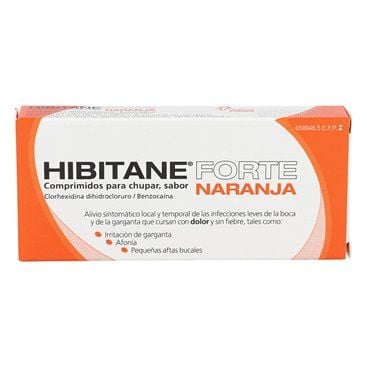Hibitane 5/5 Mg 20 Orange Sucking Tablets
Local and temporary symptomatic relief of mild infections of the mouth and throat that are painful and fever-free, such as sore throat, hoarseness, and small canker sores.
Local and temporary symptomatic relief of mild infections of the mouth and throat that are painful and fever-free, such as sore throat, hoarseness, and small canker sores.
Hibitane (5/5 Mg 20 Orange Sucking Tablets)
ACTION AND MECHANISM
- Association of local anesthetic type ester and antiseptic. Benzocaine works by blocking sensory receptors on mucous membranes locally. Chlorhexidine is a broad spectrum antiseptic with special activity against gram-positives, it also has a fungistatic effect against Candida.
INDICATIONS
- Symptomatic relief of [ORAL INFECTION] and [PHARYNGITIS], which occur with pain and without fever (sore throat, [AFONIA], [RONQUERA], [ORAL AFTAS]).
POSOLOGY
- Adults and children over 6 years: 1 tablet / 2 h. Do not exceed 8 tablets / day.
RULES FOR THE CORRECT ADMINISTRATION
Dissolve slowly in the mouth, without chewing or swallowing.
CONTRAINDICATIONS
- [ALLERGY TO LOCAL ANESTHETICS TYPE ESTER] to PABA or parabens or paraphenylenediamine (a hair dye), or to clohexidine.
- Children under 6 years of age, due to their special sensitivity to the systemic toxicity of benzocaine, which may cause methemoglobinemia.
PRECAUTIONS
- If after two days of treatment the symptoms are aggravated or accompanied by fever, headache, nausea or vomiting, consult your doctor.
ADVICE TO THE PATIENT
- Administration is not recommended in children younger than 3 years (normal tablets and mint forte) or 6 years old (orange flavor forte tablets).
- The tablets should not be chewed or swallowed, since their action is local.
- You can permanently color the fillings if the surface or its margins are rough.
- Maintain adequate oral hygiene, with special anti-tartar toothpaste, to reduce the accumulation of anti-tartar and the coloration caused by chlorhexidine.
SPECIAL WARNINGS
- In patients with periodonditis, chlorhexidine causes an increase in supragingival stones.
INTERACTIONS
Due to the presence of benzocaine, it interferes with:
- Cholinesterase inhibitors: they inhibit the metabolism of the local anesthetic, with the risk of increased systemic toxicity.
- Sulfamides: Benzocaine metabolites can antagonize the antibacterial activity of sulfa drugs.
PREGNANCY
There are insufficient data on the use of chlorhexidine and benzocaine in pregnant women.
Chlorhexidine: Fertility disorders, fetotoxic actions, or peri-post natal toxicity have not been described in studies with experimental animals.
Benzocaine: No problems with benzocaine have been described in pregnancy.
LACTATION
It is not known whether chlorhexidine is excreted in human milk. No problems with benzocaine in lactation have been reported.
CHILDREN
Due to its benzocaine content, it should not be administered to children under 6 years of age. Children are more sensitive to the systemic toxicity of benzocaine, being able to produce methemoglobinemia.
ADVERSE REACTIONS
Adverse effects are generally mild and transient. The most characteristic are:
-Occasionally, brown discoloration of the teeth, fillings, false teeth and other oral appliances and the tongue. The coloration of the tongue disappears spontaneously and is not dangerous. The coloration of the teeth is not permanent, it can be removed by oral cleaning. The coloring of fillings can be permanent.
- When starting treatment, temporary taste changes and a burning mouth sensation may appear.
- Increased tartar.
- Rare cases of oral irritation due to scaly, sometimes painful lesions (especially in children between 10 and 18 years), which is usually transient, and irritation of the tip of the tongue have been described.
- Also in rare occasions local allergic reactions that, sometimes, appeared accompanied by nasal congestion, itching, skin rash.
- Itching, itching, swelling or redness inside or around the mouth.
Adverse reactions that may arise from the presence of benzocaine are due to excessive dosing or rapid absorption, as well as the patient's idiosyncrasy, and include sensitization by contact and angioedema (by allergic reaction or contact dermatitis).
OVERDOSE
At the proposed doses, it is difficult to produce a picture of overdose.
- Symptoms: due to chlorhexidine, especially in children, symptoms of alcohol poisoning (stammering speech, numbness or staggering gait). Symptoms due to benzocaine: CNS stimulation (symptoms are blurred or double vision, dizziness, seizures, ringing of the ears, excitement), followed by CNS depression (drowsiness), depression of the cardiovascular system, increased sweating, low blood pressure or heartbeat slow or irregular. Methaemoglobinemia (difficulty breathing, dizziness, fatigue, tiredness, weakness) may also appear.
- Treatment: as regards chlorhexidine, it is fundamentally symptomatic. Administer oxygen or institute assisted breathing, and for circulatory depression, administer a vasoconstrictor and intravenous fluids. Treatment of methemoglobinemia: methylene blue.



